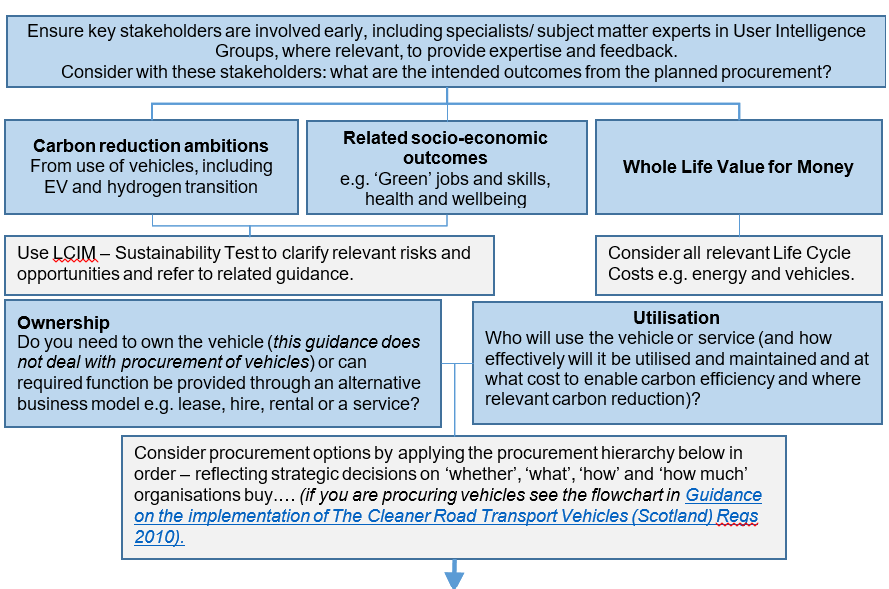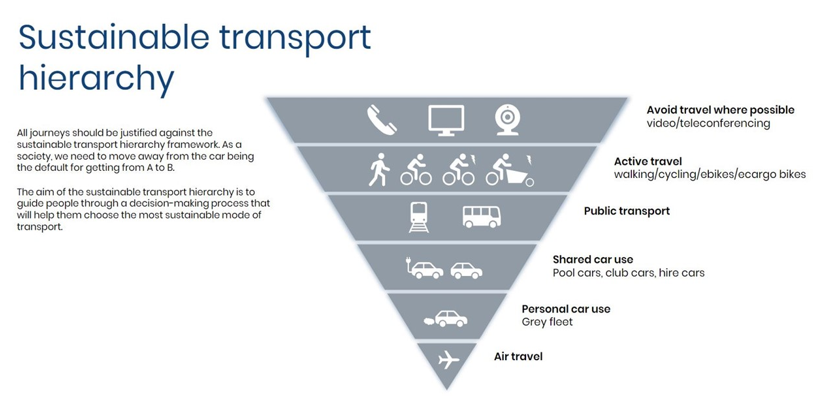As the Procurement Journey emphasises, the most positive outcomes, including those relating to vehicle use, will arise from early consideration, involving key stakeholders, of intended outcomes and the optimum solution(s).

1. Do you really need to buy?
Can you reduce vehicles and carbon emissions by reducing the amount procured?
Can you satisfy need by making optimum use of existing vehicles already owned, by refurbishing / reusing from elsewhere?
2. Can you meet the need in a lower carbon way?
Innovative or disruptive technologies can radically change the way a need is met.
Can the need be future proofed including delivery through an alternative business model e.g. ‘product as a service’ where the supplier retains ownership of the vehicle or through the provision of ‘mobility’ services?
Can the required service be delivered in a way that reduces carbon emissions (such as the use of ‘ecargobikes’ for local deliveries, in lieu of Light or Heavy Goods Vehicles?).
Can a service be delivered remotely via Microsoft Teams or another distance learning platform?
3. If you need to buy
Focus on the carbon emissions that relate to the use of vehicles at the procurement stage.
This may be applied through relevant standards and/or outcome-based requirements.
This can help to reduce the life cycle cost of ownership for the end user as well as carbon. This helps to justify the investment of higher upfront costs, where relevant.
The Sustainable Travel Hierarchy pictured below should be used to inform investment decisions and ensure transport options that focus on reducing inequalities and the need to travel unsustainably are prioritised.

[Alt text: the picture displays the Sustainable Transport Hierarchy as an upside-down pyramid with options at the top of the pyramid being preferred over those at the bottom. The hierarchy from top to bottom is 1 - avoid travel where possible (i.e. video/teleconferencing), 2 - active travel (i.e. walking/cycling/ebikes/ecargo bikes), 3 - public transport, 4 - shared car use (i.e. pool cars, club cars, hire cars), 5 - personal car use (i.e. grey fleet), 6 - air travel. The image also includes the following text description:
All journeys should be justified against the sustainable travel hierarchy framework. As a society, we need to move away from the car being the default for getting from A to B. The aim of the sustainable transport hierarchy is to guide people through a decision-making process that will help them choose the most sustainable mode of transport]
Mature dialogue - allow sufficient time for mature dialogue with the market early to set out your vehicle and carbon objectives and determine the nature of the potential market. This signals your intent to the market (as well as internal stakeholders), and a basis for measuring and managing overall performance - including through the use of Prior Information Notices (PIN)/ Request for Information (RFI)/ Market events.
Innovation - this includes opportunities for innovative low or zero carbon vehicle (or transport) solutions, which may be essential to enable the transition to ‘Net Zero’. Cross functional working is essential to encourage and enable opportunities for innovation, involving all those who influence intended procurement budgets and outcomes. For example, are policy and mechanisms in place to consider alternatives to ‘the norm’; is the finance function in the public body supportive of innovative approaches? Do they allow / encourage ‘invest to save’ and similar?
Capability - how capable is the market in delivering these ambitions? The maturity of the market regarding low / zero carbon vehicles/ transport can vary across categories e.g. an increasing number of construction contractors have embraced the use of electric plant and some clients may require justification in advance if the contractor wishes to use diesel plant, some FM contractors are now routinely using or trialling electric vans, while other service providers are less advanced, in part due to costs.
The availability and development of electric vehicle charging infrastructure will inevitably impact on the ability of some suppliers to rapidly transition, while electricity supply companies will be planning for increased electricity demand as a result of this. Buyers should ensure the speed of such development, in a dynamic market, and the length of a relevant contract/ framework is considered when setting requirements.